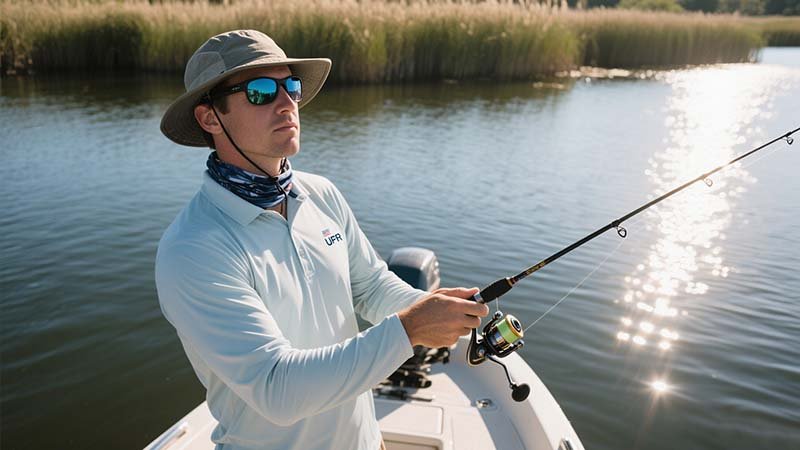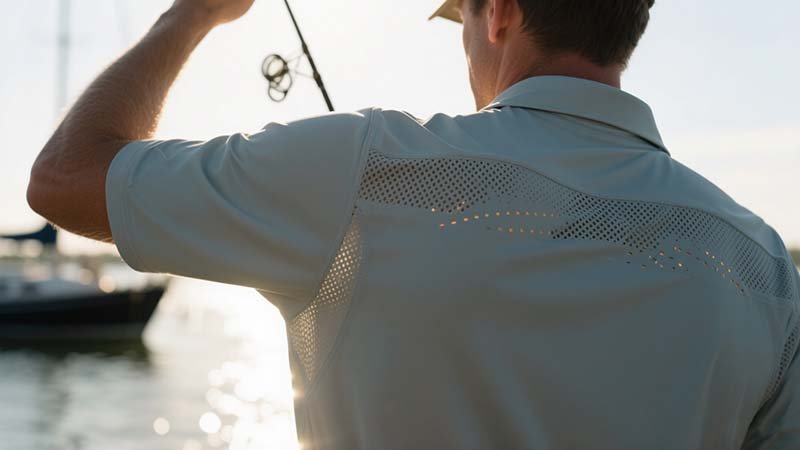
Last summer, I wore a regular polo to a weekend fishing trip—big mistake. I was sweating like crazy, sunburned by noon, and uncomfortable the whole time. That’s when I knew: not all polos are created equal.
Fishing polos vs. regular polos—what’s the real difference?
Fishing polo shirts are built for performance, especially on the water. They’re made with technical fabrics that dry fast, offer superior UV protection, and resist stains, while regular polos focus more on casual looks. If you're out fishing under the sun, trust me—your regular polo just won’t cut it.
Let’s break it all down so you can choose the right shirt for your next trip.
Fishing Polo Fabric vs. Regular: Which Material Performs Better on the Water?
Most regular polos are made from cotton or cotton blends. Sounds comfy, right? But out on the water, cotton holds onto sweat, dries slow, and gets heavy. Not ideal.
Fishing polos, on the other hand, use performance fabrics like polyester or poly-spandex blends. These materials wick away moisture fast, dry quickly, and won’t cling to you when things get hot and humid. It’s the kind of difference you only notice once you’ve been soaked in sweat and salt spray.

Fabric Technology: Why It Matters
When you're casting lines under the sun, the fabric against your skin makes all the difference.
Regular Polo Materials
| Material | Pros | Cons |
|---|---|---|
| Cotton | Soft, breathable | Absorbs sweat, dries slowly, wrinkles |
| Cotton-Poly Blend | Slightly faster drying | Still lacks wicking power, can feel heavy when wet |
Fishing Polo Materials
| Material | Pros | Cons |
|---|---|---|
| 100% Polyester | Quick-dry, lightweight, durable | Can feel less soft if not brushed |
| Poly-Spandex | Stretchy, breathable, fast-dry | Costs more, but worth it |
I once wore a fishing polo made from a poly-spandex blend on a hot Florida trip—it was a lifesaver. While my buddy in a regular polo was drenched and miserable, I stayed cool, dry, and ready to reel in another one.
UV Protection Showdown: Why Fishing Polos Offer Better Sun Defense
Have you ever peeled off a regular polo after a day in the sun and found a farmer’s tan—or worse, a sunburn? Me too. Regular polos just aren’t built for UV defense.
Fishing polos come with built-in UPF (Ultraviolet Protection Factor), often rated UPF 30 to 50+, shielding your skin from harmful rays. They act like a wearable sunscreen, which means fewer burns and longer days doing what you love.

The Truth About Sun Protection
Most cotton polos don’t offer much more than a UPF 5—barely better than being shirtless. Polyester fishing polos are treated to reflect UV rays, giving you that extra peace of mind.
UV Comparison
| Shirt Type | Typical UPF Rating |
|---|---|
| Regular Cotton Polo | UPF 5-10 |
| Fishing Performance Polo | UPF 30-50+ |
Add in a neck gaiter or long sleeves, and you’re practically sunproof.
Stay Cool While Casting: How Fishing Polos Beat Regular Shirts in Ventilation

Out on the lake, when the sun’s blazing, staying cool is everything. I’ve worn regular polos that felt like a sauna. But my fishing polos? Like a breath of fresh air.
Fishing polos are engineered for airflow. Mesh-lined vents, lightweight fabrics, and sweat-wicking designs mean heat doesn’t stick around. Regular polos? They trap heat and sweat, especially under the arms and collar.
Built to Breathe
Many fishing shirts feature:
- Back vents with mesh panels
- Underarm eyelets or laser-cut holes
- Lightweight knits that let air pass through
I wore one with a vented back during a redfish tournament—game changer. Even after five hours on deck, I felt fresh enough to grab lunch without changing.
Built to Last: Why Fishing Polos Resist Stains, Sweat, and Salt Better Than Regular Polos
Fishing isn’t a clean sport. There’s bait, fish slime, sunscreen, saltwater—and that mystery sauce from the boat sandwich. Regular polos soak it all up and hold on tight.
Fishing polos are built tough. Their fabrics resist stains, won’t hold onto fishy smells, and are easier to rinse clean. Some even have anti-microbial coatings to keep things fresh after a long day out.
Durability Breakdown
| Feature | Regular Polo | Fishing Polo |
|---|---|---|
| Stain Resistance | Low | High |
| Odor Control | Low | Medium to High (with treatment) |
| Saltwater Tolerance | Poor | Excellent |
| Fade Resistance | Low | High (especially in dyed polyester) |
I’ve had a fishing polo survive a full week offshore without turning into a stink bomb. My regular polo? Let’s just say it never recovered from that tuna trip.
Conclusion
If you're serious about fishing—or even just want to enjoy it comfortably—ditch the regular polo. A fishing polo’s fabric, features, and function are designed for the water. Your skin, sweat glands, and fishing game will thank you.
.png)

